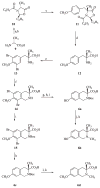Synthesis and in vitro opioid receptor functional antagonism of methyl-substituted analogues of (3R)-7-hydroxy-N-[(1S)-1-{[(3R,4R)-4-(3-hydroxyphenyl)-3,4-dimethyl-1-piperidinyl]methyl}-2-methylpropyl]-1,2,3,4-tetrahydro-3-isoquinolinecarboxamide (JDTic)
- PMID: 19954245
- PMCID: PMC5584631
- DOI: 10.1021/jm900756t
Synthesis and in vitro opioid receptor functional antagonism of methyl-substituted analogues of (3R)-7-hydroxy-N-[(1S)-1-{[(3R,4R)-4-(3-hydroxyphenyl)-3,4-dimethyl-1-piperidinyl]methyl}-2-methylpropyl]-1,2,3,4-tetrahydro-3-isoquinolinecarboxamide (JDTic)
Abstract
In previous structure-activity relationship (SAR) studies, (3R)-7-hydroxy-N-[(1S)-1-{[(3R,4R)-4-(3-hydroxyphenyl)-3,4-dimethyl-1-piperidinyl]methyl}-2-methylpropyl]-1,2,3,4-tetrahydro-3-isoquinolinecarboxamide (JDTic, 3) was identified as the first potent and selective kappa-opioid receptor antagonist from the trans-3,4-dimethyl-4-(3-hydroxyphenyl)piperidine class of opioid antagonists. In the present study, we report the synthesis of analogues 8a-p of 3 and present their in vitro opioid receptor functional antagonism using a [(35)S]GTPgammaS binding assay. Compounds 8a-p are analogues of 3 containing one, two, or three methyl groups connected to the JDTic structure at five different positions. All the analogues with one and two added methyl groups with the exception of 8k had subnanomolar K(e) values at the kappa receptor. The three most potent analogues were the monomethylated (3R)-7-hydroxy-N-[(1S,2S)-1-{[(3R,4R)-4-(3-hydroxyphenyl)-3,4-dimethylpiperidine-1-yl]methyl}-2-methylbutyl]-1,2,3,4-tetrahydroisoquinoline-3-carboxamide (8a) and (3R)-7-hydroxy-N-[(1S)-1-{[(3R,4R)-4-(3-hydroxyphenyl)-3,4-dimethylpiperidin-1-yl]methyl}-(2-methylpropyl)]-3-methyl-1,2,3,4-tetrahydroisoquinoline-3-carboxamide (8e) with K(e) values of 0.03 nM at the kappa receptor and (3R)-7-hydroxy-N-[(1S)-1-{[(3R,4R)-4-(3-methoxyphenyl)-3,4-dimethylpiperidin-1-yl]methyl}-2-methylpropyl]-1,2,3,4-tetrahydroisoquinoline-3-carboxamide (8d) with K(e) = 0.037 nM at the kappa receptor. All three compounds were selective for the kappa receptor relative to the micro and delta receptors. Overall, the results from this study highlight those areas that are tolerant to substitution on 3.
Figures




Similar articles
-
The discovery and development of the N-substituted trans-3,4-dimethyl-4-(3'-hydroxyphenyl)piperidine class of pure opioid receptor antagonists.ChemMedChem. 2014 Aug;9(8):1638-54. doi: 10.1002/cmdc.201402142. Epub 2014 Jun 30. ChemMedChem. 2014. PMID: 24981721 Free PMC article. Review.
-
Synthesis and in vitro opioid receptor functional antagonism of analogues of the selective kappa opioid receptor antagonist (3R)-7-hydroxy-N-((1S)-1-{[(3R,4R)-4-(3-hydroxyphenyl)-3,4-dimethyl-1-piperidinyl]methyl}-2-methylpropyl)-1,2,3,4-tetrahydro-3-isoquinolinecarboxamide (JDTic).J Med Chem. 2008 Mar 27;51(6):1849-60. doi: 10.1021/jm701344b. Epub 2008 Feb 29. J Med Chem. 2008. PMID: 18307295
-
Identification of (3R)-7-hydroxy-N-((1S)-1-[[(3R,4R)-4-(3-hydroxyphenyl)- 3,4-dimethyl-1-piperidinyl]methyl]-2-methylpropyl)-1,2,3,4-tetrahydro- 3-isoquinolinecarboxamide as a novel potent and selective opioid kappa receptor antagonist.J Med Chem. 2003 Jul 3;46(14):3127-37. doi: 10.1021/jm030094y. J Med Chem. 2003. PMID: 12825951
-
Discovery of the first small-molecule opioid pan antagonist with nanomolar affinity at mu, delta, kappa, and nociceptin opioid receptors.ACS Chem Neurosci. 2015 Apr 15;6(4):646-57. doi: 10.1021/cn500367b. Epub 2015 Feb 18. ACS Chem Neurosci. 2015. PMID: 25635572 Free PMC article.
-
Lovastatin.2019 Jul 20. Drugs and Lactation Database (LactMed®) [Internet]. Bethesda (MD): National Institute of Child Health and Human Development; 2006–. 2019 Jul 20. Drugs and Lactation Database (LactMed®) [Internet]. Bethesda (MD): National Institute of Child Health and Human Development; 2006–. PMID: 30000417 Free Books & Documents. Review.
Cited by
-
The discovery and development of the N-substituted trans-3,4-dimethyl-4-(3'-hydroxyphenyl)piperidine class of pure opioid receptor antagonists.ChemMedChem. 2014 Aug;9(8):1638-54. doi: 10.1002/cmdc.201402142. Epub 2014 Jun 30. ChemMedChem. 2014. PMID: 24981721 Free PMC article. Review.
-
Enantioselective Synthesis of Tetrahydroquinolines, Tetrahydroquinoxalines, and Tetrahydroisoquinolines via Pd-Catalyzed Alkene Carboamination Reactions.Chem Sci. 2014 Dec 1;5(12):4840-4844. doi: 10.1039/C4SC01327A. Chem Sci. 2014. PMID: 25431650 Free PMC article.
-
Synthesis and preliminary evaluation of 4-hydroxy-6-(3-[11C]methoxyphenethyl)pyridazin-3(2H)-one, a 11C-labeled d-amino acid oxidase (DAAO) inhibitor for PET imaging.Bioorg Med Chem Lett. 2020 Aug 15;30(16):127326. doi: 10.1016/j.bmcl.2020.127326. Epub 2020 Jun 9. Bioorg Med Chem Lett. 2020. PMID: 32631531 Free PMC article.
-
Characterization of BU09059: a novel potent selective κ-receptor antagonist.ACS Chem Neurosci. 2014 Mar 19;5(3):177-84. doi: 10.1021/cn4001507. Epub 2014 Jan 28. ACS Chem Neurosci. 2014. PMID: 24410326 Free PMC article.
-
Potent and Selective Tetrahydroisoquinoline Kappa Opioid Receptor Antagonists of Lead Compound (3 R)- N-[1 R)-1-(Cyclohexylmethyl)-2-methylpropyl]-7-hydroxy-1,2,3,4-tetrahydroisoquinoline-3-carboxamide (CDTic).J Med Chem. 2018 Sep 13;61(17):7546-7559. doi: 10.1021/acs.jmedchem.8b00674. Epub 2018 Aug 29. J Med Chem. 2018. PMID: 30032602 Free PMC article.
References
-
- Volkow ND, Li TK. Drug addiction: the neurobiology of behaviour gone awry. Nat Rev Neurosci. 2004;5:963–970. - PubMed
-
- Nestler EJ, Carlezon WA., Jr The mesolimbic dopamine reward circuit in depression. Biol Psychiatry. 2006;59:1151–1159. - PubMed
-
- Pfeiffer A, Brantl V, Herz A, Emrich HM. Psychotomimesis mediated by kappa opiate receptors. Science. 1986;233:774–776. - PubMed
Publication types
MeSH terms
Substances
Grants and funding
LinkOut - more resources
Full Text Sources
Other Literature Sources
Miscellaneous

